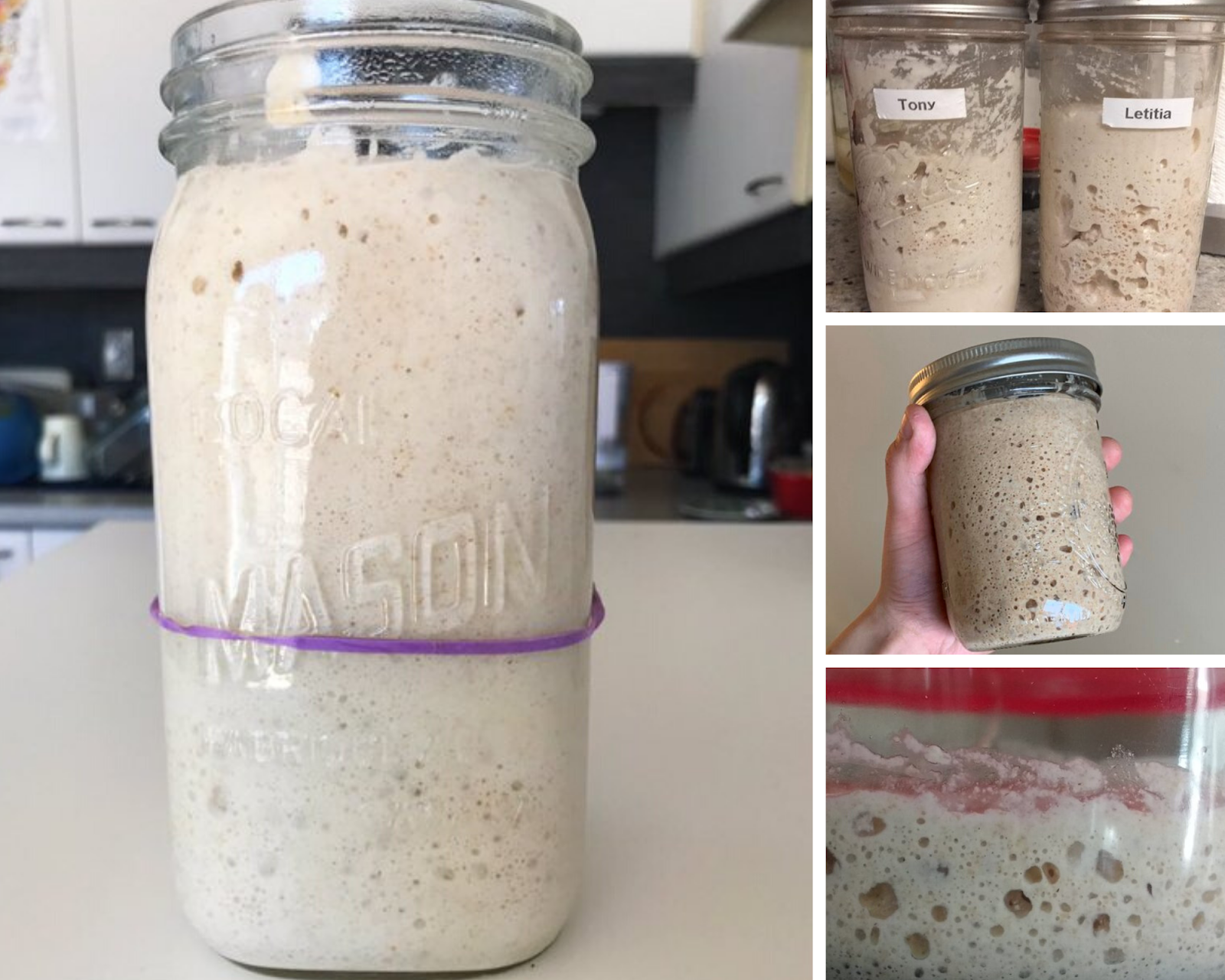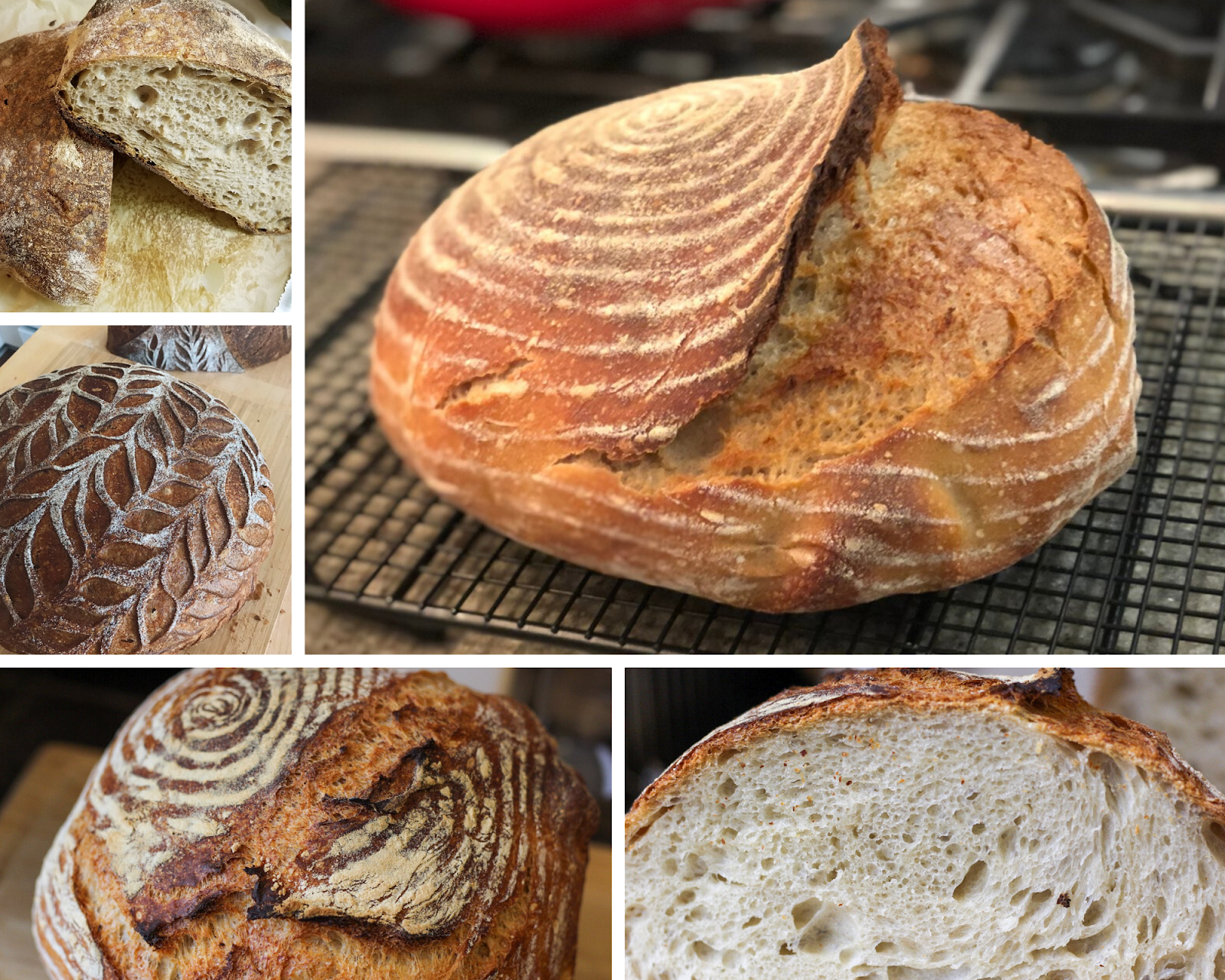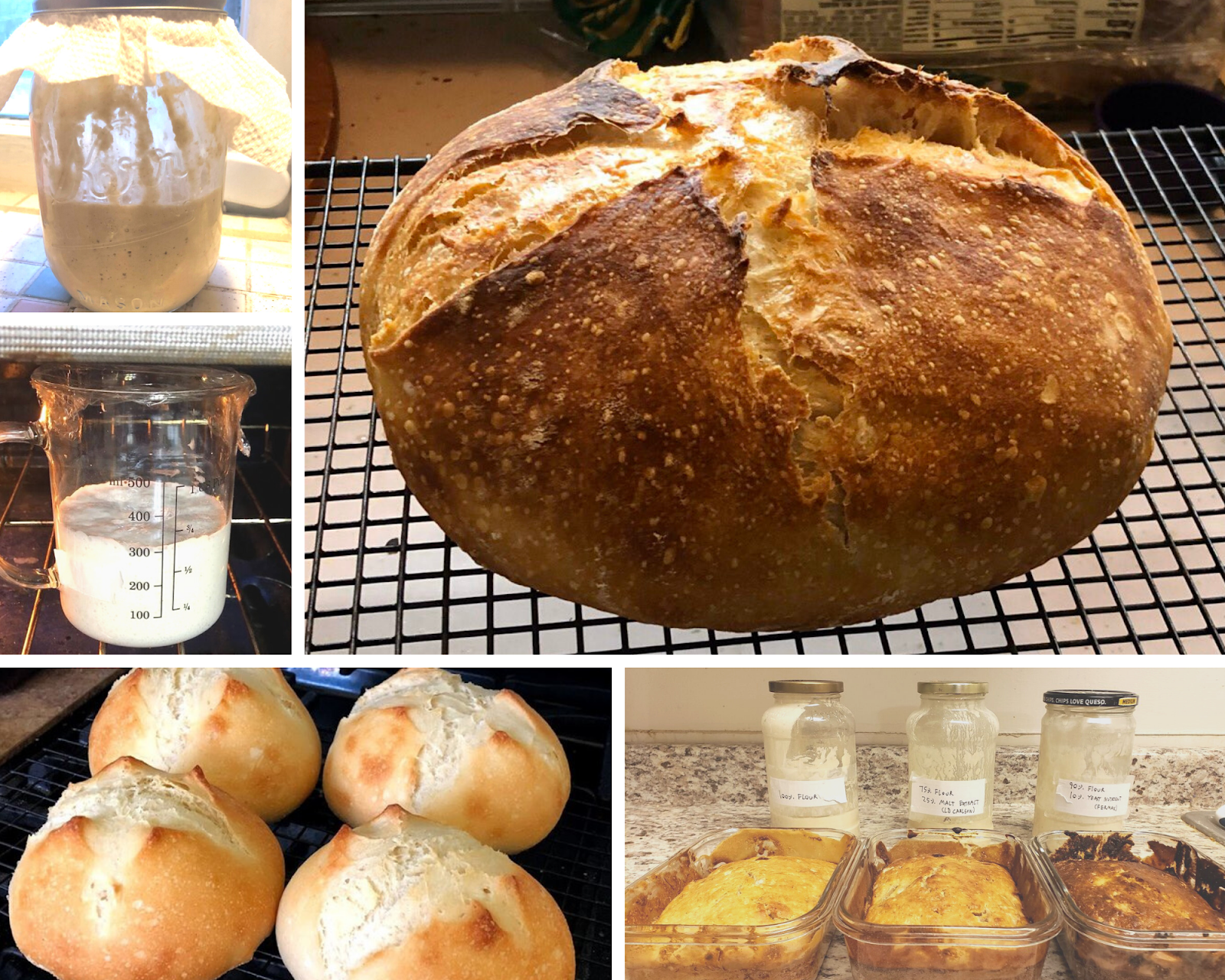When you smell bread baking in the oven, it wraps you up like your favorite blanket. Isn’t that wonderful? The comforting activity of bread baking can sometimes involve the use of a sourdough starter, which is alive with microbes.
Bread baking, in general, requires something to make it rise — a leavening agent. The leavening agent can be baking soda, baking powder, or yeast, all of which create carbon dioxide bubbles causing the bread to rise. Here, we’re interested in the microbial leavening agent yeast, but specifically, those yeasts that inhabit sourdough starter cultures. Yeast is not the only microbe making its home in sourdough starters. They also contain bacteria. And together, these microbes make for a much more complex bread than those made with baker’s yeast.
So, this post is all about sourdough starters, what they are, the difference between baking bread with a sourdough starter vs. simply adding baker’s yeast, what the microbes in those starters do, and how you can make your own sourdough starter. Get ready. If you aren’t already acutely aware of the presence of microbes everywhere, you will be after reading this post.
This post contains affiliate links — see my disclosure policy.
A sourdough starter is an active culture of yeast and bacteria living in flour and water that can be used to bake sourdough bread. You can create your very own starter at home or buy a sourdough starter online (dry or wet).
Using a packet of baker’s yeast to bake bread is highly controlled and easy because you do not have to grow and maintain a sourdough starter. If you grow a sourdough starter, it takes some time, about a week or two. But the beauty of sourdough starters is that you can make bread without buying yeast from the store. Instead, you cultivate yeast that lives in the flour, air, and environment where you grow your starter. You get to be a microbe gardener.

Sourdough starters. Photos kindly provided by (clockwise from left) Sólveig Hanson, Jeffrey Letourneau, Clara R, and Jennifer Tsang.
This type of fermentation — where you start fermentation using the microbes present on or in the food that you’re fermenting, in the environment, or even on you — is called spontaneous fermentation. I love the idea of spontaneous fermentation because the microbes cost you nothing (no need to spend a penny on baker’s yeast or any other starter culture). And you realize how many microbes are present in our daily lives. Let’s be honest. It feels a bit like magic.
Another example of spontaneous fermentation is sauerkraut fermentation. You cut up some cabbage, salt it, squish it, and make sure that the liquid released from the cabbage covers it. Then, you let it ferment. And it’s simply the microbes that are living on the cabbage that do the work for you. It’s pretty amazing to me.
It’s been a mystery for a long time as to where exactly the microbes in sourdough starters come from, whether it’s the flour, the environment itself, the bakers, or even the water. Sidenote about the water, though: there are not very many organisms that live in water, and they’re not the organisms that actually are involved in making a sourdough starter. The bacteria and yeast in starters seem to mostly come from the flour but can also come from baker’s hands.
With sourdough, you have a microbial community that produces more flavors than you would get from making bread with baker’s yeast.

Sourdough loaf. Photos kindly provided by Elaine Gardener.
Most of the flavor comes from the bacteria in the sourdough starter. Lactic acid bacteria make the sour flavors (lactic acid and acetic acid – vinegar). The bacteria produce other flavors such as diacetyl, a buttery flavor, as well, so you get a more complex and interesting loaf of bread from a sourdough starter.
The main job of the yeast is to create the fluffy texture of the bread. The yeast ferments the sugars in the flour and produces carbon dioxide bubbles that cause the bread to rise.
Sourdough bread made from different starters is completely unique to you, the environment, and the flour that you’re using. Your sourdough starter has its own personality. Its unique qualities — the appearance, the aroma, the flavor — will come from the different bacteria and the yeast that end up making a home in your sourdough starter. Some will be sourer, sweeter, or more buttery. The sourdough bread you make from your own starter is a bread that no one else could create.

Sourdough loaves. Photos kindly provided by (clockwise from top left) Patrik D’haeseleer, Petra Levin, Sean Leonard (2 photos), and Sólveig Hanson.
There’s a surprising amount of information that we don’t yet know about sourdough starters. For instance, we still don’t know all of the different microbes that are in sourdough starters from different locations or that come from different types of flour. So, researchers are surveying which microbes are in starters from around the world. This project actually involves everyday folks — it’s a citizen science project. Rob Dunn’s lab at North Carolina State University is running The Global Sourdough Project. They’ve finished taking participants and are now in the phase of analyzing the data.
If you would like to participate in a sourdough citizen science project, though, the Dunn lab is currently accepting participants for the Wild Sourdough Project. Through this project, they seek to determine the contribution of different flours and locations on the unique qualities of each person’s sourdough, including aroma, appearance, and rising time/height. So, check that project out if you are interested in making your own starter and characterizing it for science.
If you are interested in making your own sourdough starter after reading this, then here it is. The concept is simple, but the process takes time and perseverance. For some, it may be straightforward, and for others, it may seem like you’ve failed after a few days. But keep going. It’s easy to overthink it — does it smell right? Does it look right? Should it be doing that?
What’s fun about it, though, is that you can choose a particular type of flour to experiment with or choose a specific location to keep it in. The basic idea is that you mix flour with water, store it in a warm location, and wait. Then, you split off half of the mixture and throw it away — I know that sounds sad, but if you don’t do this step, you will end up with a massive amount of dough. Then add more flour and water. You will begin to see bubbles, and the smell of it will change over time. After 7-14 days, you will have a sourdough starter.
Sounds pretty simple, right? Just know that it is a commitment. Just like a pet, you have to feed it every day, sometimes twice a day. It’s also easy to overthink it. The protocol I recommend following is from the Wild Sourdough project. So, go check it out. They have plenty of details and a frequently asked questions page over there.

Sourdough loaves and starters. Photos kindly provided by (clockwise from top left) Janet Paper (2 photos), Reed Stubbendieck, and Mona Wu Orr.
Making bread with baker’s yeast is simple. Use yeast. Rise the dough. Make the bread. And sourdough, on the other hand, is admittedly a commitment. But sourdough bread bakers don’t mind that commitment. Their starters become like a pet, even down to naming them. One of my friends actually named her sourdough starter after me because she knows how much I love fermented foods. (Click here to read the fermented foods series.)
So, if you need more convincing to decide whether or not to grow a sourdough starter, think about it this way. You get to have your own microbial community that you cultivate like your own personal microbial garden or pet that you can name. If you try it out, tag me on social media and tell me what you’ve decided to name it.
Thank you to everyone on Twitter who was kind enough to contribute photos of their sourdough pets full of bubbly goodness.
The post Your sourdough starter is a garden of microbes appeared first on Joyful Microbe.
Bread baking, in general, requires something to make it rise — a leavening agent. The leavening agent can be baking soda, baking powder, or yeast, all of which create carbon dioxide bubbles causing the bread to rise. Here, we’re interested in the microbial leavening agent yeast, but specifically, those yeasts that inhabit sourdough starter cultures. Yeast is not the only microbe making its home in sourdough starters. They also contain bacteria. And together, these microbes make for a much more complex bread than those made with baker’s yeast.
So, this post is all about sourdough starters, what they are, the difference between baking bread with a sourdough starter vs. simply adding baker’s yeast, what the microbes in those starters do, and how you can make your own sourdough starter. Get ready. If you aren’t already acutely aware of the presence of microbes everywhere, you will be after reading this post.
This post contains affiliate links — see my disclosure policy.
What is a sourdough starter?
A sourdough starter is an active culture of yeast and bacteria living in flour and water that can be used to bake sourdough bread. You can create your very own starter at home or buy a sourdough starter online (dry or wet).
Bread baking: sourdough starter vs. baker’s yeast
Using a packet of baker’s yeast to bake bread is highly controlled and easy because you do not have to grow and maintain a sourdough starter. If you grow a sourdough starter, it takes some time, about a week or two. But the beauty of sourdough starters is that you can make bread without buying yeast from the store. Instead, you cultivate yeast that lives in the flour, air, and environment where you grow your starter. You get to be a microbe gardener.
Sourdough starters. Photos kindly provided by (clockwise from left) Sólveig Hanson, Jeffrey Letourneau, Clara R, and Jennifer Tsang.
This type of fermentation — where you start fermentation using the microbes present on or in the food that you’re fermenting, in the environment, or even on you — is called spontaneous fermentation. I love the idea of spontaneous fermentation because the microbes cost you nothing (no need to spend a penny on baker’s yeast or any other starter culture). And you realize how many microbes are present in our daily lives. Let’s be honest. It feels a bit like magic.
Another example of spontaneous fermentation is sauerkraut fermentation. You cut up some cabbage, salt it, squish it, and make sure that the liquid released from the cabbage covers it. Then, you let it ferment. And it’s simply the microbes that are living on the cabbage that do the work for you. It’s pretty amazing to me.
It’s been a mystery for a long time as to where exactly the microbes in sourdough starters come from, whether it’s the flour, the environment itself, the bakers, or even the water. Sidenote about the water, though: there are not very many organisms that live in water, and they’re not the organisms that actually are involved in making a sourdough starter. The bacteria and yeast in starters seem to mostly come from the flour but can also come from baker’s hands.
What do the microbes in sourdough starters do?
With sourdough, you have a microbial community that produces more flavors than you would get from making bread with baker’s yeast.
Sourdough loaf. Photos kindly provided by Elaine Gardener.
Most of the flavor comes from the bacteria in the sourdough starter. Lactic acid bacteria make the sour flavors (lactic acid and acetic acid – vinegar). The bacteria produce other flavors such as diacetyl, a buttery flavor, as well, so you get a more complex and interesting loaf of bread from a sourdough starter.
The main job of the yeast is to create the fluffy texture of the bread. The yeast ferments the sugars in the flour and produces carbon dioxide bubbles that cause the bread to rise.
Sourdough bread made from different starters is completely unique to you, the environment, and the flour that you’re using. Your sourdough starter has its own personality. Its unique qualities — the appearance, the aroma, the flavor — will come from the different bacteria and the yeast that end up making a home in your sourdough starter. Some will be sourer, sweeter, or more buttery. The sourdough bread you make from your own starter is a bread that no one else could create.
Sourdough loaves. Photos kindly provided by (clockwise from top left) Patrik D’haeseleer, Petra Levin, Sean Leonard (2 photos), and Sólveig Hanson.
There’s a surprising amount of information that we don’t yet know about sourdough starters. For instance, we still don’t know all of the different microbes that are in sourdough starters from different locations or that come from different types of flour. So, researchers are surveying which microbes are in starters from around the world. This project actually involves everyday folks — it’s a citizen science project. Rob Dunn’s lab at North Carolina State University is running The Global Sourdough Project. They’ve finished taking participants and are now in the phase of analyzing the data.
If you would like to participate in a sourdough citizen science project, though, the Dunn lab is currently accepting participants for the Wild Sourdough Project. Through this project, they seek to determine the contribution of different flours and locations on the unique qualities of each person’s sourdough, including aroma, appearance, and rising time/height. So, check that project out if you are interested in making your own starter and characterizing it for science.
How to make your own sourdough starter
If you are interested in making your own sourdough starter after reading this, then here it is. The concept is simple, but the process takes time and perseverance. For some, it may be straightforward, and for others, it may seem like you’ve failed after a few days. But keep going. It’s easy to overthink it — does it smell right? Does it look right? Should it be doing that?
What’s fun about it, though, is that you can choose a particular type of flour to experiment with or choose a specific location to keep it in. The basic idea is that you mix flour with water, store it in a warm location, and wait. Then, you split off half of the mixture and throw it away — I know that sounds sad, but if you don’t do this step, you will end up with a massive amount of dough. Then add more flour and water. You will begin to see bubbles, and the smell of it will change over time. After 7-14 days, you will have a sourdough starter.
Sounds pretty simple, right? Just know that it is a commitment. Just like a pet, you have to feed it every day, sometimes twice a day. It’s also easy to overthink it. The protocol I recommend following is from the Wild Sourdough project. So, go check it out. They have plenty of details and a frequently asked questions page over there.
Sourdough loaves and starters. Photos kindly provided by (clockwise from top left) Janet Paper (2 photos), Reed Stubbendieck, and Mona Wu Orr.
Making bread with baker’s yeast is simple. Use yeast. Rise the dough. Make the bread. And sourdough, on the other hand, is admittedly a commitment. But sourdough bread bakers don’t mind that commitment. Their starters become like a pet, even down to naming them. One of my friends actually named her sourdough starter after me because she knows how much I love fermented foods. (Click here to read the fermented foods series.)
So, if you need more convincing to decide whether or not to grow a sourdough starter, think about it this way. You get to have your own microbial community that you cultivate like your own personal microbial garden or pet that you can name. If you try it out, tag me on social media and tell me what you’ve decided to name it.
Further Reading and Listening
- Thread on Twitter by Seamus Blackley, who created bread from ancient Egyptian yeast
- Ologies episode: interview with Seamus Blackley
- Gastropod episode: interview with Rob Dunn and Anne Madden about where the microbes in sourdough starters come from
- Rob Dunn’s Sourdough Projects
Thank you to everyone on Twitter who was kind enough to contribute photos of their sourdough pets full of bubbly goodness.
The post Your sourdough starter is a garden of microbes appeared first on Joyful Microbe.
